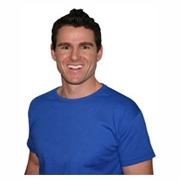How To Reduce Diet-Related Stress
by Matt O'Neil (BSpSc, MSc(Nut&Diet) � Founder of SmartShape.com.au)
 Is your diet a source of stress for you or your clients? Matt O�Neill provides some insight into how healthy your diet needs to be and tips to reduce food-related stress.
Is your diet a source of stress for you or your clients? Matt O�Neill provides some insight into how healthy your diet needs to be and tips to reduce food-related stress.
Food as a source of stress? Seems a bit weird at first -- after all, isn�t eating one of life�s pleasures and a daily activity to be enjoyed? Not so, according to almost half of the people who participated in one of my recent online surveys.
In the survey, �my diet� was rated as the most common cause of stress with 47% of respondents rating their diet as �often� (29%) or �always� (18%) causing stress. Diet ranked higher as a source of frequent stress than �work demands� and �not having enough money�.
Why does diet cause stress?
Stress or more appropriately the perception of stress occurs when you feel you don�t have the capacity to deal with something that is challenging you. One potential source of diet-related stress is trying to make your diet healthier than is practically possible at the outset of your programme. You start your diet by cutting out everything that you hear is bad for you, including caffeine, alcohol, artificial sweeteners and find it too tough to stick to.
Combating TDH Syndrome
This is what I sometimes call TDH Syndrome. The TDH stands for Too Damn Healthy. This is characterised by an individual believing they need to exclude caffeine, sugar, alcohol and many other dietary components from their diet to be healthy. TDH can extend to becoming vegetarian and only eating organically grown foods from day one of a new diet.
Whilst these eating habits are healthy, they can be too much to manage when you attempt to make them part of your diet all at once. The stress caused by worrying about how you will be able to keep up all these healthy habits triggers a dietary blow-out and you fall off your healthy eating program.
If this picture is familiar for you or some of your clients, then TDH Syndrome may be the cause. Here are some suggestions to combat this.
Build one or two healthy eating habits at a time. For example, first aim to eat 2-3 pieces of fruit each day, and then make sure you serve a generous quantity of vegetables at dinner. Once you are confident that you have incorporated more fruits and vegetables into your eating pattern, add another healthy habit, such as limiting alcohol or caffeine.
This gradual approach allows you to celebrate small successes at every stage of your new diet, rather than pinning all your success on your ability to abstain from dietary components you need to cut back on. By taking on your new diet step-by-step you may even surprise yourself by cutting back on alcohol without having to try too hard. As you start to feel healthier and fitter, you may naturally start to say to yourself, �My body is temple, not a mad scientist�s laboratory� and make extra enhancements.
Going cold turkey does work for some people and not others. If you or your client have an unsuccessful history of dietary abstinence, then a new approach that sets weekly diet targets, celebrates success and adds new targets will help build a uniquely successful healthy eating pattern.
Matt O'Neill provides instant resources and training on nutrition, weight loss and fitness challenges for fitness businesses at www.SmartShape.com.au
Click here For Matt�s FREE REPORT to get the facts about �Meal Timing & Weight Loss� and subscribe to his website.
|
|
|









 Is your diet a source of stress for you or your clients? Matt O�Neill provides some insight into how healthy your diet needs to be and tips to reduce food-related stress.
Is your diet a source of stress for you or your clients? Matt O�Neill provides some insight into how healthy your diet needs to be and tips to reduce food-related stress.